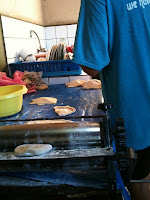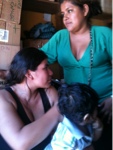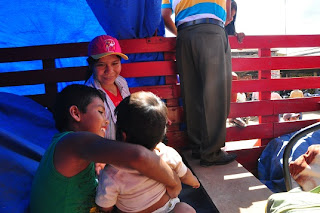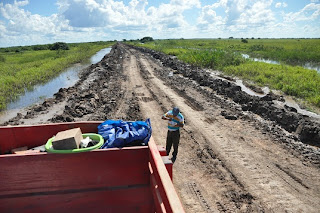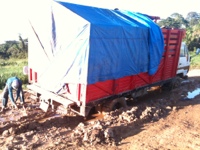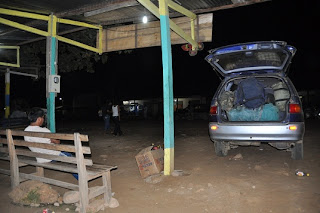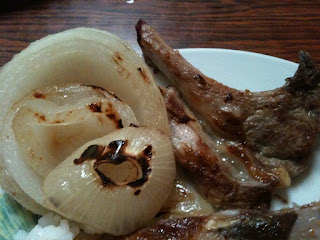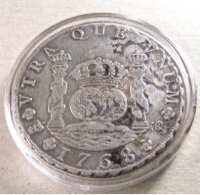Our host, Rafael, suggested us taking a taxi to his place. As he said, going downtown was only B$18.
The town was in a circular zone system and Rafael's apartment in city centre was actually in zone 1.
We arrived at around 7am, rang the bell and no one answered. After a while, we quited. We left our backpack in the lobby and went for a walk in the neighborhood.
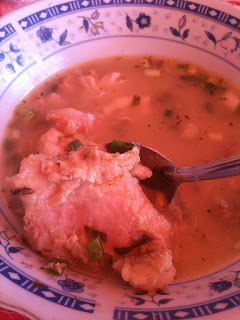 We found a wet market with food stores selling fish soup, pescaderia with huge fish cut into fillets, a few vegetable and fruit stalls, some shoes repair and clothes repair stalls and food stall selling yogurt with fruit salad, fresh juice, fresh empanadas, bread, coffee and tea. The fish soup costing only B$10 was so great! The meaty river fish goes well with the finely chopped parsley and spring onion. They goes with yucca, corn and lemon. We also had a small jug of fresh papaya juice, then coffee and empanadas. We are very glad to fill our stomach with all cheap local breakfast stalls. And I'm able to get my torn pant repair with B$10.
We found a wet market with food stores selling fish soup, pescaderia with huge fish cut into fillets, a few vegetable and fruit stalls, some shoes repair and clothes repair stalls and food stall selling yogurt with fruit salad, fresh juice, fresh empanadas, bread, coffee and tea. The fish soup costing only B$10 was so great! The meaty river fish goes well with the finely chopped parsley and spring onion. They goes with yucca, corn and lemon. We also had a small jug of fresh papaya juice, then coffee and empanadas. We are very glad to fill our stomach with all cheap local breakfast stalls. And I'm able to get my torn pant repair with B$10.We returned to the apartment and found the guys just woke up.
Rafael is a 5th year medical student from Brazil, who lived with 2 others schoolmates. Eduardo is of the same year and Ricardo is in 4th year. We appreciate their hospitality despite their examination week.
We took care of ourselves by visiting the markets, museums and planning a 3d/2n trip to Samaipata, a serene town 2-3 hours away from Santa Cruz, which is close to Amboro National Park, with the hope that we could find cheaper ways to hike there on our own.
 |
| we came across the Bolivian pageant events for the sponsor of the crown |
Our first two days in Santa Cruz was walking around town. We had lunch with the 3 Brazilian guys in a food court of a shopping mall, having churrasco, barbecue beef with rice and other assortments. Then, we went for a walk in downtown.
 In the central area, there is the plaza and church. And the tourism information centre, along with some museums.
In the central area, there is the plaza and church. And the tourism information centre, along with some museums.We stayed in an unusually tall building in Calle Cuellar, which is nearby the Los Pozos market. There are 2 more plazas around town.
We reached the museum, Museo Ethno-Folklórico in park El Arenal near Los Pozos market and found its closed and workers are bringing in logs. We don't know I'd it's under renovation or changing to something else.
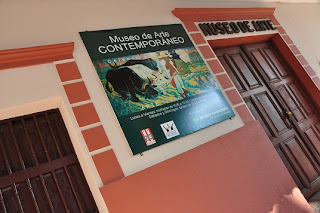 Actually, we don't have much luck in Santa Cruz, except the unforgettable fish soup and nice, cheap fresh fruit juice. We visited the modern art museum on Sunday, which said it will be opened at 3pm-6pm on Sunday, when we reached there at 11:30am. We hanged around in the market and Central for some fruit juice and icecream, returned and found that the door was locked.
Actually, we don't have much luck in Santa Cruz, except the unforgettable fish soup and nice, cheap fresh fruit juice. We visited the modern art museum on Sunday, which said it will be opened at 3pm-6pm on Sunday, when we reached there at 11:30am. We hanged around in the market and Central for some fruit juice and icecream, returned and found that the door was locked. The first night, we made some Chinese fried rice for the guys. Eduardo prepared shisha after dinner and we had a good time chatting. (hope we haven't disturbed their study)
 The second night, we visited a restaurant, Casa del Camba, recommended by Rafael and LP, which is famous for local specialties and parrilla. We reached there are only found groups and groups of tourist. It's a nicely furnished restaurant, with live music and a 2 person parrilla set, beer and a jug of chicha (local alcohol brewed by corn) cost us a total of B$144. Not too bad for tourist price, but the barbecue plate was composed of not thoroughly washed grilled kidney, liver, intestines (still keeping the unpleasant odor of beef) and there was only 1 piece of steak and 1 piece of sausage.
The second night, we visited a restaurant, Casa del Camba, recommended by Rafael and LP, which is famous for local specialties and parrilla. We reached there are only found groups and groups of tourist. It's a nicely furnished restaurant, with live music and a 2 person parrilla set, beer and a jug of chicha (local alcohol brewed by corn) cost us a total of B$144. Not too bad for tourist price, but the barbecue plate was composed of not thoroughly washed grilled kidney, liver, intestines (still keeping the unpleasant odor of beef) and there was only 1 piece of steak and 1 piece of sausage.We spent 3 days in Samaipata and returned on Saturday to join Rafael birthday party. They started a barbecue in the roof top from mid day, while Ricardo was the chef. It goes on all day with beer, whiskey and nonstop jugs of caipirinha. The guys are all trashed and we managed to sneak out buying bus ticket for the next day. Being too old to party overnight, we see the young ones off at 1am, guys refreshed in shirt and pants, girls in full makeup and dazzles heading for pub to dance the night away.
A little more walk around town, we left on Sunday late afternoon. The house was still a little chaotic for the maid to sort it out, probably on Monday.
Good luck to the guys on their exam week and we are happy to join a great birthday party celebrated in Brazilian style.

